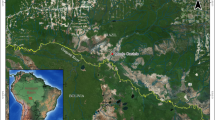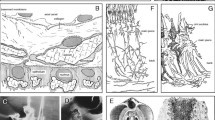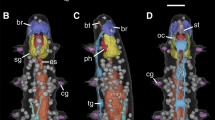Abstract
X-ray tomographic methods have been evaluated for their suitability to visualise morphology and anatomy of fossil fruits and seeds preserved in the oil shale of the Middle Eocene Messel Formation (former Lake Messel, near Darmstadt, Germany). Micro-computed tomography (microCT) is suitable for evaluation of gross morphology and tissue preservation. Synchrotron radiation X-ray tomographic microscopy (SRXTM) enables visualisation of gross morphology, tissues, and their detailed cellular structure. Of 30 taxa studied, only 4 exhibit good cellular detail. The reason for lack of detail in other taxa is unclear but may be related to subtle variations in chemical composition or physical structure of their tissues. X-ray tomographic data also permit structures, such as locule casts, to be visualised, giving additional features for comparison with other extinct and extant taxa. X-ray tomography has revealed important features of Messel specimens, which have (1) provided key taxonomic characters and supported recognition of new taxa, some of which are the earliest fossil representatives of modern genera (Pleiogynium, Anacardiaceae; Berchemia, Rhamnaceae), (2) demonstrated the absence of modifications for epizoochory in this flora, and (3) revealed aspects of exceptional preservation relevant to mammal and bird diet (e.g. soft tissue in fruits of Vitaceae).






Similar content being viewed by others
References
Chandler MEJ (1961) The Lower Tertiary floras of Southern England. I Palaeocene floras. London Clay Flora (Supplement) Text and Atlas. British Museum (Natural History), London
Chandler MEJ (1964) The Lower Tertiary floras of Southern England. IV. A summary and survey of findings in the light of recent botanical observations. British Museum (Natural History), London
Collinson ME (1983) Fossil plants of the London Clay. Field guides to fossils no. 1. The Palaeontologcial Association, London
Collinson ME (1988) The special significance of the middle Eocene fruit and seed flora from Messel, West Germany. Cour Forsch-Inst Senckenberg 107:187–197
Collinson ME, Cleal CJ (2001a) The palaeobotany of the Palaeocene and Palaeocene-Eocene transitional strata in Great Britain. In: Cleal CJ, Thomas BA, Batten DJ, Collinson ME (eds) Mesozoic and tertiary palaeobotany of Great Britain, geological conservation review, vol 22. Joint Nature Conservation Committee, Peterborough, pp 155–184
Collinson ME, Cleal CJ (2001b) Early and early-middle Eocene (Ypresian-Lutetian) palaeobotany of Great Britain. In: Cleal CJ, Thomas BA, Batten DJ, Collinson ME (eds) Mesozoic and Tertiary palaeobotany of Great Britain, geological conservation review, vol 22. Joint Nature Conservation Committee, Peterborough, pp 185–226
Collinson ME, Cleal CJ (2001c) Late middle Eocene-early Oligocene (Bartonian-Rupelian) and Miocene palaeobotany of Great Britain. In: Cleal CJ, Thomas BA, Batten DJ, Collinson ME (eds) Mesozoic and tertiary palaeobotany of Great Britain, geological conservation review, vol 22. Joint Nature Conservation Committee, Peterborough, pp 227–274
Collinson ME, Manchester SR, Wilde V, Hayes P (2010) Fruit and seed floras from exceptionally preserved biotas in the European Paleogene. Bull Geosci 85:155–162
Collinson ME, Manchester SR, Wilde V (2012) Fossil fruits and seeds of the Middle Eocene Messel biota, Germany. Abh Senckenberg Ges Naturforsch 570:1–251
Goth K (1990) Der Messeler Ölschiefer—ein Algenlaminit. Cour Forsch-Inst Senckenberg 131:1–143
Herrera F, Manchester SR, Hoot SB, Wefferling KM, Carvalho MR, Jaramillo C (2011) Phytogeographic implications of fossil endocarps of Menispermaceae from the Paleocene of Colombia. Am J Bot 98:2004–2017
Irion G (1977) Der eozäne See von Messel. Natur und Museum 107:213–218
Lenz OK, Wilde V, Riegel W, Harms F-J (2010) A 600 kyr record of El Niño Southern Oscillation (ENSO): evidence for persisting teleconnections during the Middle Eocene greenhouse. Geology 38:627–630
Lenz OK, Wilde V, Riegel W (2011) Short-term fluctuations in vegetation and phytoplankton during the Middle Eocene greenhouse climate: a 640-kyr record from the Messel oil shale (Germany). Int J Earth Sci 100:1851–1874
Mai DH (1995) Tertiäre Vegetationsgeschichte Europas. Gustav Fischer, Jena
Manchester SR (1994) Fruits and seeds of the Middle Eocene Nut Beds Flora, Clarno Formation, Oregon. Palaeontogr Am 58:1–205
Manchester SR, Wilde V, Collinson ME (2007) Fossil cashew nuts from the Eocene of Europe: biogeographic links between Africa and South America. Int J Plant Sci 168:1199–1206
Marone F, Münch B, Stampanoni M (2010) Fast reconstruction algorithm dealing with tomography artifacts. SPIE Proceedings “Developments in X-Ray Tomography VII” 7804, 780410, doi:10.1117/12.859703
Schaal S (ed) (2005) Messel Pit fossil site: snapshots of the Eocene. Vernissage, 21/05:1-67
Schaal S, Ziegler W (eds) (1992) Messel: an insight into the history of life and of the Earth. Clarendon, Oxford
Selden P, Nudds J (2004) Evolution of fossil ecosystems. University of Chicago Press, Chicago
Smith SY, Collinson ME, Rudall PJ (2008) Fossil Cyclanthus (Cyclanthaceae, Pandanales) from the Eocene of Germany. Am J Bot 95:688–699
Smith SY, Collinson ME, Simpson DA, Rudall PJ, Marone F, Stampanoni M (2009a) Elucidating the affinities and habitat of ancient, widespread Cyperaceae: Volkeria messelensis gen. et sp. nov., a fossil mapanioid sedge from the Eocene of Europe. Am J Bot 96:506–1518
Smith SY, Collinson ME, Rudall PJ, Simpson DA, Marone F, Stampanoni M (2009b) Virtual taphonomy using synchrotron tomographic microscopy reveals cryptic features and internal structure of modern and fossil plants. Proc Natl Acad Sci USA. doi:10.1073/pnas.0901468106
Stampanoni M, Groso A, Isenegger A, Mikuljan G, Chen Q, Bertrand A, Henein S, Betemps R, Frommherz U, Böhler P, Lange M, Abela R (2006) Trends in synchrotron-based tomographic imaging: The SLS experience. In: Bonse U (ed) Proceedings of SPIE Developments in X-ray tomography V: 6318: 6318 M-1–6318 M-14
Acknowledgements
We would like to thank Karin Schmidt and Martin Müller at the Senckenberg Forschungsinstitut und Naturmuseum in Frankfurt am Main (SFN) for their technical help and enthusiastic support for all aspects of our work on Messel material. Sarah Joomun and Nathan Sheldon are thanked for their assistance with work at the TOMCAT beamline. Funding was provided from the Integrated Infrastructure Initiative (I3) on Synchrotrons and FELs through SLS to M.E.C. and S.Y.S. Richie Abel helped with the early stages of CT work at the Natural History Museum. Avizo work by D.S.F.F. and B.E.R. was undertaken in partial fulfillment of the requirements for degrees (BSc and MSci, respectively) of Royal Holloway University of London. This work was undertaken by S.Y.S during the tenure of a fellowship from the Michigan Society of Fellows, which is gratefully acknowledged. We much appreciated helpful comments on the manuscript from Rolf Mathewes and one anonymous referee.
Author information
Authors and Affiliations
Corresponding author
Additional information
This article is a contribution to the special issue "Messel and the terrestrial Eocene - Proceedings of the 22nd Senckenberg Conference"
Rights and permissions
About this article
Cite this article
Collinson, M.E., Smith, S.Y., Manchester, S.R. et al. The value of X-ray approaches in the study of the Messel fruit and seed flora. Palaeobio Palaeoenv 92, 403–416 (2012). https://doi.org/10.1007/s12549-012-0091-7
Received:
Accepted:
Published:
Issue Date:
DOI: https://doi.org/10.1007/s12549-012-0091-7




